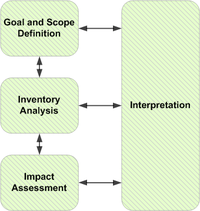
Photo from wikipedia
Abstract The apparel industry is responsible for 10% of the world's carbon emissions, and is considered as the second highest industrial polluter after the oil industry. In Sri Lanka, the… Click to show full abstract
Abstract The apparel industry is responsible for 10% of the world's carbon emissions, and is considered as the second highest industrial polluter after the oil industry. In Sri Lanka, the apparel sector is the key foreign revenue earner, and developing a sustainable apparel industry will provide a competitive and strategic advantage to the Sri Lankan apparel products in the global market. However, limited data availability and a lack of studies carried out to quantify environmental impacts and propose mitigation strategies have detrimentally affected the growth of the Sri Lankan apparel industry. This study proposes a framework to quantify the environmental impacts due to energy use in garment production in the Sri Lankan apparel industry. Initially, the impacts were quantified using life cycle assessment with a gate-to-gate approach, based on the specific energy use and energy sources being used in the major production and transportation phases in a garment's life cycle. A case study was then conducted based on the data from an apparel production facility located in Sri Lanka. The life cycle impacts of energy use of the selected process phases were compared to identify the most critical processes in terms of the environmental footprint. Finally, the study was extended to investigate the effects of using different alternative energy supply scenarios. The life cycle impact assessment was conducted using the ReCiPe (Ver 1.11) Midpoint method in SimaPro. The findings revealed that the garment production phase carries the highest life cycle impacts among the studied process phases from fabric manufacture to distribution to the end market. Scenario analysis showed that the use of solar photovoltaics and biomass to supply the required electricity and thermal energy for apparel manufacturing can reduce climate change, ozone depletion, and terrestrial acidification by 90–95%. This information can be used by decision makers to plan for sustainability and growth of the apparel industry.
Journal Title: Journal of Cleaner Production
Year Published: 2018
Link to full text (if available)
Share on Social Media: Sign Up to like & get
recommendations!